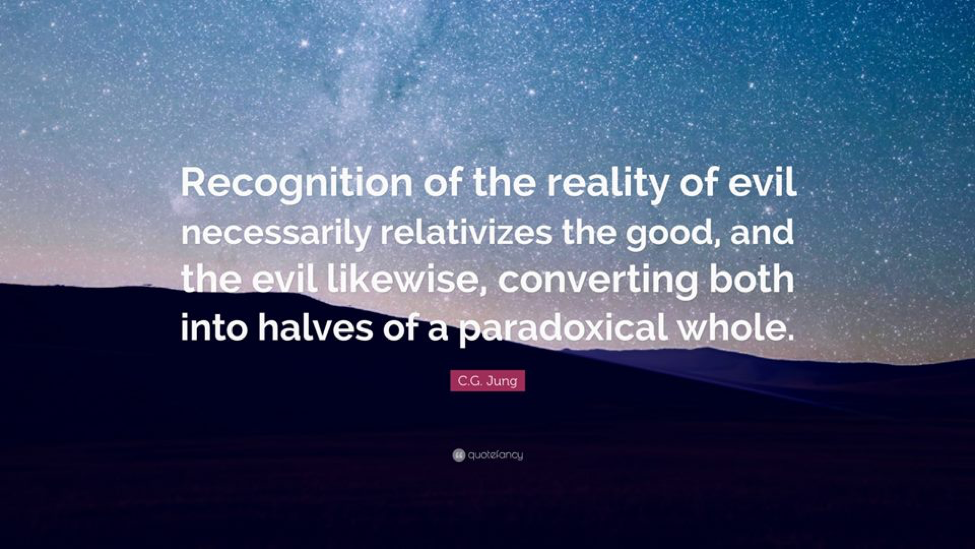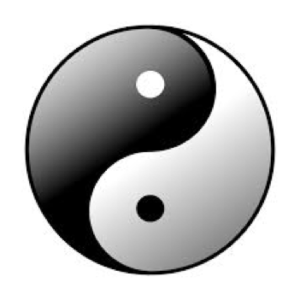President’s Column for the Positive Living Newsletter (November 2016) Read the rest of the newsletter here.

Since the INPM is home of second wave positive psychology (PP 2.0), this month I will continue to examine this topic so that our readers can have a better understanding of the three basic tenets of PP 2.0.
The most fundamental tenet or the overarching conceptual framework for PP 2.0 is the Yin-Yang dialectics as illustrated in the above Carl Jung quote and a quote from Tao Te Ching (道德經), written by Lao-tzu (老子) and translated into English by Stephen Mitchell (1988):
When people see some things as beautiful,
Other things become ugly.
When people see some things as good,
Other things become bad.
Being and non-being create each other.
Difficult and easy support each other.
Long and short define each other.
High and low depend on each other.
Before and after follow each other.
How emotionally liberating and transformative it is, once we learn to accept and appreciate the reality of opposites or the principle of Yin (negative and passive) and Yang (positive and active)! How much more non-judgemental and tolerant we will become, once we look at life from this perspective!
The actual working or processes of Yin-Yang dialectics necessarily entail two other basic tenets: (1) Accepting the dark side of life as an inevitable part of the human condition, and (2) Transcending both positives and negatives through Yin-Yang dialectics.
The Principles of Acceptance through Yin-Yang
PP 2.0 begins with the assumption that life is full of suffering and evil, just as physicians and medical scientists begin with the assumption that we live in an environment full of bacteria and viruses. Therefore, acceptance is the necessary first step towards transforming the inevitable negative experiences into positive motivations and personal growth through Yin-Yang dialectics. Mindful acceptance is helpful to increase our awareness and regulate our negative emotions (McKay & West, 2016).
There are at least three basic principles of acceptance necessary for our well-being: (a) Accept life in its totality or the whole of life, not just the parts we like; (b) the whole is always made up of opposites or polarities, such as good and evil, positive and negative; and (c) opposites depend on or complement each other, thus, light depends on the existence of darkness.
By applying these principles of acceptance (the Yin of coping), we will be in a much better position to commit ourselves to pursue valued goals and personal growth (the Yang of adaptation). Research on Acceptance Commitment Therapy (ACT) supports this conclusion (Ruiz, 2010).
In view of the above, it is both unrealistic and even harmful, if we only focus on the bright side of life, because it will lead to unnecessary frustration and disappointment (Ivtzan, Lomas, Hefferon, & Worth, 2015).
When we accept our present suffering as just a transitory part of all the vicissitudes of life, our burden is lifted. When we embrace good and evil, happiness and sadness, as two sides of the same coin, we naturally practice the virtues of temperance and the practical wisdom of balance.
Peterson and Park (2012) raised a provocative rhetorical question: “What good is critical thinking if not accompanied by uncritical caring?” (p. 279). Similarly, Wong (2016b) suggests that achievement needs to be balanced by acceptance of one’s own limitation. Thus, whatever one’s strength, whatever one’s source of meaning, it needs to be balanced by an opposite quality to avoid hubris or excesses.
The Principles of Transcendence through Yin-Yang
 Yin-Yang means more than the reality that positives can be negative, and vice versa. There are at least three transcendental principles in Yin-Yang dialectics.
Yin-Yang means more than the reality that positives can be negative, and vice versa. There are at least three transcendental principles in Yin-Yang dialectics.
- Yin-Yang can always be subdivided, as illustrated by the Yin-Yang symbol. Yang is embedded within Yin, and Yin is embedded within Yang. There is always a finer differentiation between Yin and Yang. This principle enables us to achieve a balanced or nuanced view of any phenomenon in life through integrating and transcending the differences between Yin and Yang.
- The balance between Yin and Yang is a dynamic process. How to achieve the right balance depends on both internal and external conditions. For instance, when a person’s inner resources are almost exhausted and the outside hostile forces are overwhelming, it would be more adaptive to have an excess of Yin with a minimum of Yang. This principle will us to transcend situational constraints and increase our flexibility in adapting to the changing demands of life and optimizing our well-being.
- The way (tao; 道) of Yin-Yang always moves towards expansion through relationships. Thus, one can become increasingly connected with other people, nature, or God as we grow older (Reed, 1991) or as we have actualized our potentials (Maslow, 1971). This principle of self-transcendence enables us to begin with self-compassion but expand with ever increasing circles of compassion and connectiveness, until the central point of the self disappears (Marsh, 2016). Thus, the principle of self-transcendence will lead to a more compassionate and harmonious society (Wong, 2016a) and a return to Yin in self-effacing humility and self-sacrifice.
Conclusion
Taken together, the three tenets of PP 2.0 will transform how we do positive psychology research and interventions. It will require a very different way of looking at life according to the enduring wisdom from the ancient book Tao Te Ching.
Yin-Yang dialectics provide a template to conceptualize life as an endless series of accepting and transcending changes in achieving the optimal balance between Yin-Yang as conceptualized in Wong’s (2012) dual-systems model of adaptation. Thus, both research and intervention requires measuring interactions between positives and negatives and changes over time.
These three tenets are applicable to both the East and West because acceptance, transcendence, and Yin-Yang dialectics are universal human phenomena, recognized by philosophers in both the East and the West. They have also been investigated by research psychologists.
Way back in 1973, William McGuire, a well-known social psychologist, advocated a shift to the new paradigm of Yin-Yang in psychology research. In 2004, an edited book titled Perspectivism in Social Psychology: The Yin and Yang of Scientific Progress (Jost, Banaji, & Prentice, 2004) was published by the American Psychological Association in honour of McGuire.
In a similar vein, David Myers (1987) has made the statement: “Reality often seems best approximated by complementary principles, each of which is by itself a half truth.” Viewed this way, a full account of human flourishing demands the integration of both negative and positive aspects of life as advocated in PP 2.0.
References
- Ivtzan, I., Lomas, T., Hefferon, K., & Worth, P. (2016). Second wave positive psychology: Embracing the dark side of life. London, UK: Routledge.
- Jost, J. T., Banaji, M. R., & Prentice, D. A. (Eds.) (2004). Perspectivism in social psychology: The yin and yang of scientific progress. Washington, DC: American Psychological Association.
- Lao-tzu. (1988). Tao te ching (Trans. S. Mitchell). New York, NY: Harper & Row.
- Marsh, A. (2016, June). Why some people are more altruistic than others. Retrieved from https://www.ted.com/talks/abigail_marsh_why_some_people_are_more_altruistic_than_others?language=en
- Maslow, A. H. (1971). The farther reaches of human nature. New York, NY: Viking Press.
- McGuire, W. J. (1973). The yin and yang of progress in social psychology: Seven koan. Journal of Personality and Social Psychology, 26(3), 446-456.
- McKay, M., & West, A. (2016). Emotion efficacy therapy: A brief, exposure-based treatment for emotion regulation integrating ACT and DBT. Oakland, CA: New Harbinger.
- Myers, D. G. (1987). Yin and yang in psychological research and Christian belief. Perspectives in Science and Christian Faith, 39, 128-139.
- Peterson, C. & Park, N. (2012). Character strengths and the life of meaning. In P. T. P. Wong (Ed.), The human quest for meaning: Theories, research, and applications (pp. 277-296). New York, NY: Routledge.
- Reed, P. G. (1991). Toward a nursing theory of self-transcendence: Deductive reformulation using developmental theories. Advances in Nursing Science, 13(4), 64-77.
- Ruiz, F. J. (2010). A review of acceptance and commitment therapy (ACT) empirical evidence: Correlational, experimental psychopathology, components and outcome studies. International Journal of Psychology and Psychological Therapy, 10(1), 125-162.
- Wong, P. T. P. (2012). Toward a dual-systems model of what makes life worth living. In P. T. P. Wong (Ed.), The human quest for meaning: Theories, research, and applications (2nd ed., pp. 3-22). New York, NY: Routledge.
- Wong, P. T. P. (2016a, July). Self-transcendence: A paradoxical way to become your best. Presidential address for the 9th Biennial International Meaning Conference in Toronto, ON.
- Wong, P. T. P. (2016b). Meaning centered positive group intervention. In P. Russo-Netzer, S. Schulenberg, & A. Batthyány (Eds.), Clinical perspectives on meaning: Positive and existential psychotherapy. New York, NY: Springer.
Cite
Wong, P. T. P. (2016, November 7). Acceptance, transcendence, and yin-yang dialectics: The three basic tenets of second wave positive psychology. Positive Living Newsletter. Retrieved from www.drpaulwong.com/inpm-presidents-report-november-2016

